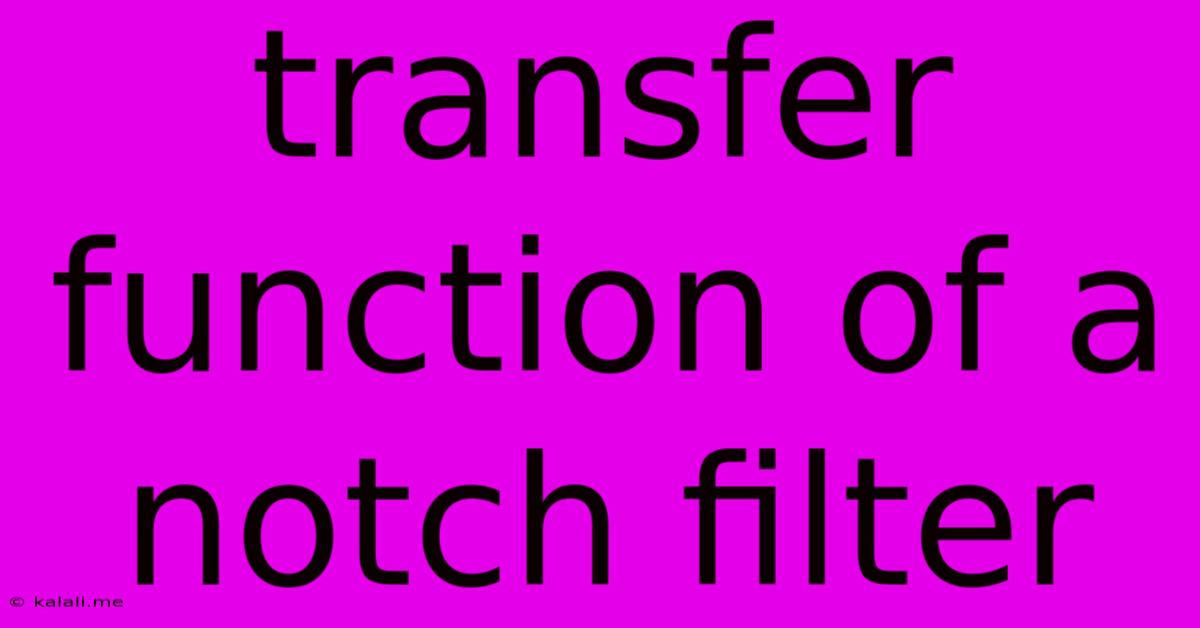Transfer Function Of A Notch Filter
Kalali
Jun 01, 2025 · 4 min read

Table of Contents
Understanding the Transfer Function of a Notch Filter
A notch filter, also known as a band-reject filter, is a crucial signal processing tool designed to attenuate or completely eliminate a specific frequency or narrow band of frequencies while allowing other frequencies to pass relatively unaffected. This selective attenuation makes them invaluable in various applications, from noise reduction in audio signals to removing power line interference in biomedical measurements. Understanding the transfer function is key to designing and implementing effective notch filters. This article will delve into the mathematical representation and practical implications of a notch filter's transfer function.
What is a Transfer Function?
Before diving into the specifics of a notch filter, let's briefly revisit the concept of a transfer function. In simple terms, a transfer function (H(s) or H(jω)) is a mathematical representation of a system's response to an input signal. It describes the relationship between the input and output signals in the frequency domain. For a linear time-invariant (LTI) system, the transfer function completely characterizes its behavior. It's usually expressed as a ratio of the Laplace transform of the output to the Laplace transform of the input.
Notch Filter Transfer Function: The Anatomy of Attenuation
The transfer function of an ideal notch filter would be a perfect "U" shape, providing infinite attenuation at the notch frequency (ω₀) and unity gain elsewhere. However, in reality, ideal filters are impossible to build. Practical notch filters achieve a sharp attenuation around the notch frequency, with the degree of attenuation determined by the filter's design and order. Common types of notch filters include:
-
Simple RC Notch Filters: These use a combination of resistors and capacitors to create a narrow band rejection. Their transfer functions are relatively simple but offer limited attenuation and selectivity.
-
Twin-T Notch Filters: Offering improved performance over simple RC filters, these use two parallel T-networks. Their transfer function exhibits a sharper notch and better rejection at the target frequency.
-
Active Notch Filters using Operational Amplifiers (Op-Amps): These circuits utilize op-amps to provide gain and sharper attenuation, often incorporating more complex transfer functions for improved performance. They're highly versatile and allow for precise control over the notch frequency and attenuation.
-
Digital Notch Filters (using DSP): Implemented using digital signal processing techniques, these offer precise control over the notch frequency and bandwidth through software. The transfer function is represented in the z-domain.
Mathematical Representation
The transfer function of a second-order notch filter can be generally represented as:
H(s) = K * (s² + ω₀²) / (s² + s(ω₀/Q) + ω₀²)
Where:
- K: Gain scaling factor.
- ω₀: Notch frequency (radians per second).
- Q: Quality factor, determining the sharpness of the notch (higher Q means sharper notch). It's related to the bandwidth of the notch. A higher Q indicates a narrower bandwidth.
- s: Complex frequency variable (s = jω).
This equation reveals the key elements influencing the filter's behavior: the notch frequency (ω₀) dictates the location of the attenuation, while the quality factor (Q) controls the sharpness of the notch. By adjusting these parameters, engineers fine-tune the filter's characteristics to meet specific application requirements. For instance, a high Q value results in a narrow notch, effectively rejecting a very specific frequency, whereas a lower Q leads to a wider notch, rejecting a small range of frequencies around ω₀.
Practical Considerations and Applications
The design and implementation of a notch filter depend heavily on its intended application and the required level of performance. Factors such as the desired notch frequency, the required attenuation, and the acceptable bandwidth all influence the selection of the appropriate filter type and its component values.
Notch filters find widespread use in various fields:
- Audio Signal Processing: Removing unwanted hum or other specific frequency noise.
- Power System Monitoring: Filtering out power line interference from sensitive measurements.
- Biomedical Signal Processing: Eliminating artifacts from biological signals like ECG or EEG.
- Control Systems: Suppressing specific frequencies in feedback loops.
By carefully analyzing and understanding the transfer function, designers can optimize notch filters for optimal performance in these and many other applications. The mathematical representation provides a powerful tool for predicting and controlling the filter's behavior, ensuring effective signal processing.
Latest Posts
Latest Posts
-
Jest Modulenamemapper Could Not Locate Module Mapped As
Jun 02, 2025
-
Why Does Water Evaporate At Room Temperature
Jun 02, 2025
-
Furnace Blowing Hot Then Cold Air
Jun 02, 2025
-
Toro Lawmower Running At Hslf Speed
Jun 02, 2025
-
Drip Edge Over Or Under Felt
Jun 02, 2025
Related Post
Thank you for visiting our website which covers about Transfer Function Of A Notch Filter . We hope the information provided has been useful to you. Feel free to contact us if you have any questions or need further assistance. See you next time and don't miss to bookmark.